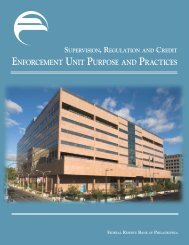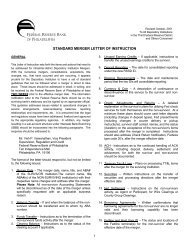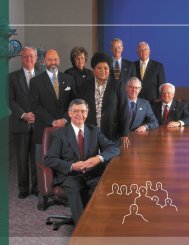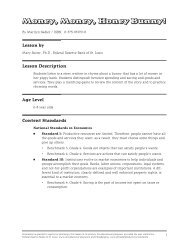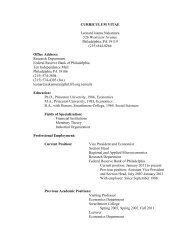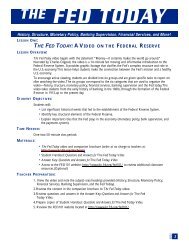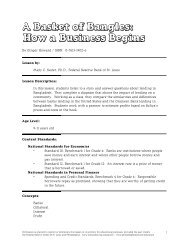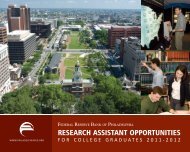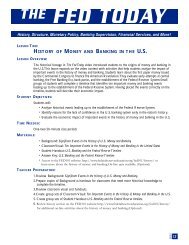The First Bank of the United States - Federal Reserve Bank of ...
The First Bank of the United States - Federal Reserve Bank of ...
The First Bank of the United States - Federal Reserve Bank of ...
You also want an ePaper? Increase the reach of your titles
YUMPU automatically turns print PDFs into web optimized ePapers that Google loves.
[Hamilton’s] ebullient leadership engendered…<br />
generated effervescent optimism that fed yet ano<strong>the</strong>r<br />
mad scramble for government securities and bank<br />
scrip, pushing <strong>the</strong>ir prices to new highs during <strong>the</strong><br />
winter <strong>of</strong> 1791-1792.” d<br />
Among <strong>the</strong> speculators was William Duer,<br />
Hamilton’s old friend and former assistant at <strong>the</strong><br />
Treasury Department. In late 1791, Duer formed a<br />
partnership with a wealthy land speculator named<br />
Alexander Macomb. <strong>The</strong>ir plan was to corner <strong>the</strong><br />
market on U.S. government securities. According<br />
to economic historian David Cowen, Duer and<br />
Macomb <strong>the</strong>n hoped to sell <strong>the</strong> appreciated assets to<br />
o<strong>the</strong>r investors at a significant pr<strong>of</strong>it. e<br />
Ano<strong>the</strong>r factor contributing to this<br />
wild speculation and subsequent crisis was <strong>the</strong><br />
unforeseen impact that <strong>the</strong> <strong>First</strong> <strong>Bank</strong> had on <strong>the</strong><br />
economy. <strong>The</strong> bank’s effect had been substantial,<br />
and its subscription sale had led to a flood <strong>of</strong> loans<br />
and banknotes in <strong>the</strong> market as investors borrowed<br />
money from o<strong>the</strong>r banks to obtain shares in <strong>the</strong> <strong>First</strong><br />
<strong>Bank</strong> and as <strong>the</strong> <strong>First</strong> <strong>Bank</strong> itself opened and began<br />
making loans and issuing its own banknotes.<br />
In addition, Duer was borrowing heavily<br />
to pay for his investments. When in early 1792<br />
<strong>the</strong> <strong>First</strong> <strong>Bank</strong> somewhat suddenly slowed <strong>the</strong><br />
expansion <strong>of</strong> its loan pool and in turn<br />
Check written by Alexander Hamilton<br />
to a Mr. Becknel on February 18, 1796, a little over a year<br />
after Hamilton left <strong>of</strong>fice as Secretary <strong>of</strong> <strong>the</strong> Treasury.<br />
<strong>The</strong> Library Company <strong>of</strong> Philadelphia.<br />
d Chernow, p. 379<br />
e See Cowen, pp. 89-90.<br />
slowed <strong>the</strong> number <strong>of</strong> banknotes it issued, f o<strong>the</strong>r<br />
banks followed suit, creating ano<strong>the</strong>r credit crunch.<br />
Unfortunately for Duer and o<strong>the</strong>r investors<br />
who had bought large amounts <strong>of</strong> U.S. government<br />
securities, <strong>the</strong>ir prices peaked in January 1792, <strong>the</strong>n<br />
started to go rapidly downhill, leading to a sell<strong>of</strong>f<br />
<strong>of</strong> <strong>the</strong>se assets in March 1792. g Duer, who had<br />
borrowed from anyone who was willing to lend, lost<br />
money on his security holdings and faced financial<br />
ruin, eventually landing in prison. h However, <strong>the</strong><br />
amount <strong>of</strong> Duer’s debt was so overwhelming and <strong>the</strong><br />
number <strong>of</strong> people and companies he had borrowed<br />
from so large that his undoing, in turn, led to<br />
widespread financial contagion. O<strong>the</strong>r investors also<br />
started to sell <strong>of</strong>f securities and default on <strong>the</strong>ir loans.<br />
This crisis has become known as <strong>the</strong> Panic <strong>of</strong> 1792.<br />
Once again, Hamilton and <strong>the</strong> o<strong>the</strong>r<br />
commissioners authorized <strong>the</strong> use <strong>of</strong> monies from<br />
<strong>the</strong> Treasury’s sinking fund to buy government<br />
securities in <strong>the</strong> open market. And, again, this<br />
activity calmed <strong>the</strong> markets and allowed <strong>the</strong><br />
fledgling U.S. financial system to return to more<br />
normal operations.<br />
In <strong>the</strong> end, <strong>the</strong> <strong>First</strong> <strong>Bank</strong> scrip bubble <strong>of</strong><br />
1791 and <strong>the</strong> Panic <strong>of</strong> 1792 did not stop <strong>the</strong> rapid<br />
development <strong>of</strong> <strong>the</strong> new nation’s economy over<br />
<strong>the</strong> next several years, although it did temporarily<br />
interrupt <strong>the</strong> economy’s growth. From today’s<br />
central banking perspective, however, <strong>the</strong>se<br />
episodes <strong>of</strong>fer <strong>the</strong> first example <strong>of</strong> <strong>the</strong> use<br />
<strong>of</strong> rudimentary open market purchases <strong>of</strong><br />
government securities to quell panic and<br />
provide liquidity to <strong>the</strong> financial system. And<br />
even though <strong>the</strong> panic was short-lived and <strong>the</strong><br />
economy quickly recovered, <strong>the</strong>se financial crises<br />
fur<strong>the</strong>r tainted <strong>the</strong> <strong>First</strong> <strong>Bank</strong>’s reputation in <strong>the</strong><br />
eyes <strong>of</strong> some and added to <strong>the</strong> level <strong>of</strong> opposition<br />
to both <strong>the</strong> <strong>First</strong> <strong>Bank</strong> and Hamilton.<br />
f See <strong>the</strong> book by Cowen, especially pp. 89-91.<br />
g Interest rates, which move in <strong>the</strong> opposite direction to <strong>the</strong> prices<br />
<strong>of</strong> securities, rose rapidly.<br />
h His friend Alexander Macomb soon joined him (Cowen, p. 90).<br />
7



